Many women develop a postpartum mommy pooch after giving birth – a bulge or rounding of the belly.
As an OBGYN, postnatal fitness trainer, and mom, I know how frustrating it can be.
My core purpose is to educate and empower women to safely heal after having a baby.
In this article, you’ll find tips to help you lose the pooch from the hundreds of postpartum women I have worked with.
Key Takeaways/ Quick Summary:
- The mommy pooch is caused by stretching and weakening of the rectus abdominis muscles and excess fat gain.
- You can lose the postpartum pooch with a consistent diet, targeted core exercises, and lifestyle changes.
- Be patient – allow four or more months for lifestyle changes to take effect.
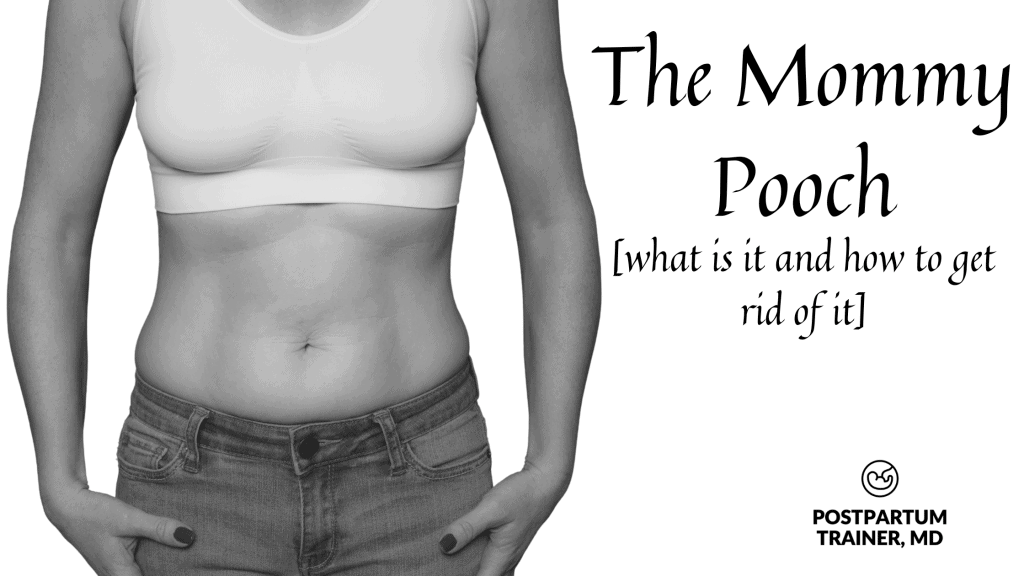
Getting rid of your mom pooch is a long-term project.
You will need to:
- lower your body fat percentage through a combination of diet and exercise, and
- perform exercises to help rebuild and restore the strength in your core.
You must do both.
Exercise alone will likely not reduce the abdominal bulge. You must improve your nutrition as well.
As far as exercises go, you should perform are ones that will help strengthen the deep, transverse abdominis muscles (aka the corset muscles.)
Here is a summary of the key strategies to help get rid of your mommy pooch:
- Tip 1: Incorporate a nutrient-dense, highly satiating, high-protein diet
- Tip 2: Incorporate transverse abdominal exercises 3x per week
- Tip 3: Be patient; it takes consistency and time
Let’s break down exactly what that entails, starting with your nutrition plan:
Tip #1 Easy Diet Strategies For New Moms
As a new mom, it can be impossibly difficult to find time to eat healthy meals.
Rather than crash diets, focus should on sustainable, realistic changes that you can do for the long-term.
Small adjustments that reduce empty carbs and calories can make a big difference.
From 5+ years of working with postpartum women, here is my take on the best meal prep strategies.
Meal Prep 101 for Busy Moms
Prepping ahead is one of the best ways to ensure that you have healthy food ready to eat. I highly recommend that you set aside some time to meal prep for 3-4 days at a time.
- Make a big batch of steel cut oatmeal with almond milk and berries for easy grab-and-go breakfasts all week
- Roast a tray of Brussels sprouts, broccoli, and sweet potatoes to pair with proteins
- Cook quinoa or brown rice in bulk to use as a base for bowls with veggies, eggs, etc
- Prepare a veggie frittata with eggs, spinach, and feta and portion into slices
- Bake or grill multiple chicken breasts to use in salads, wraps, soups
Prioritize Macronutrients
- Focus meals around lean protein and healthy fats first
- Then add veggie carbs like leafy greens, cauliflower, and broccoli
- For additional carbs, focus on sweet potatoes, butternut squash and carrots.
- You do not need to eliminate sweets/alcohol – just save them for special occasions!
Sample 2-Week Postpartum Meal Plan
Week 1
- Breakfast: Veggie egg muffins (prep a batch to heat up throughout week)
- Lunch: Mason jar salads with chicken, greens, avocado dressing
- Dinners: Chicken fajitas with greens and sweet potatoes
- Snack: Apple with almond butter
Week 2
- Breakfasts: Overnight oats
- Lunch: Burrito bowls with tofu, rice and veggies
- Dinner: Veggie omelet with Ezekiel toast
- Snack: Banana with chia seeds and coconut yogurt
Other Dietary Strategies To Reduce Belly Bloat Postpartum
Other ways you could try to get rid of your mommy pooch include:
Eating small meals
Research indicates it doesn’t matter if you eat several small meals or three larger meals daily for weight loss. (source)
However, eating small meals throughout the day will prevent you from consuming much food in one sitting.
Large meals can cause you to feel bloated and make your bulge more obvious.
If you still need to, try eating 4-5 small meals throughout the day.
You could also try adding some fantastic and healthy postpartum snacks.
Chew your food thoroughly
Have you ever noticed that when you eat fast, your abdomen swells?
That is because you swallow a lot of air when you eat quickly.
This air can bloat your intestines, further enhancing the mommy pooch.
When you sit down to eat, try to
- put away the phone,
- turn off the TV,
- take your time,
- and pay attention to the food you consume.
Experience all the flavors, chew everything in its entirety and enjoy your food.
Try yogurt
Another thing you can try is adding yogurt to your regimen.
Yogurt is full of probiotics- which are good bacteria.
Unfortunately, your diet can sometimes alter your gut microbiome, leading to an overgrowth of “bad bacteria.”
These harmful bacteria can wreak havoc on your digestive system, causing problems like constipation, diarrhea, bloating, gas, etc.
Yogurt is a simple way to help restore a healthy gut microbiome. Yogurt is also full of essential nutrients like calcium, magnesium, phosphorous, B vitamins, and protein.
In addition, it will help you stay fuller longer and curb your appetite.
Ensure you buy the unsweetened flavor with zero sugar. Excess sugar may further aggravate your bloating, accentuating your mommy tummy.
You could add some fruit, chia seeds, and granola for a more satiating snack.
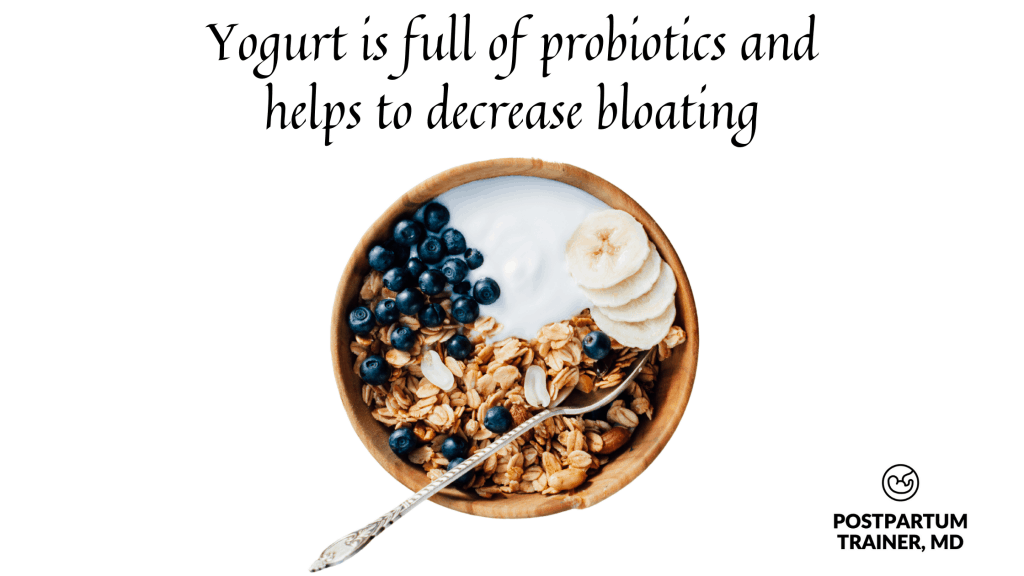
Related Post: A Simple & Effective Postpartum Diet For Busy Moms
Tip #2: Do Targeted Core Exercises With This Mommy pooch workout
The mommy pooch belly is caused by stretching and weakening of the rectus abdominis muscles.
This connective tissue holding the muscles together is known as the linea alba. As this tissue weakens, your abdominal muscles will separate along the midline.
To repair these muscles, you must learn how to strengthen the deep, transverse abdominis muscles.
The transverse abdominis muscle wraps around your entire midsection to create a corset around your torso.
The easiest way to use this muscle is by doing posterior pelvic tilts.
Here’s what it looks like:
Posterior Pelvic Tilts
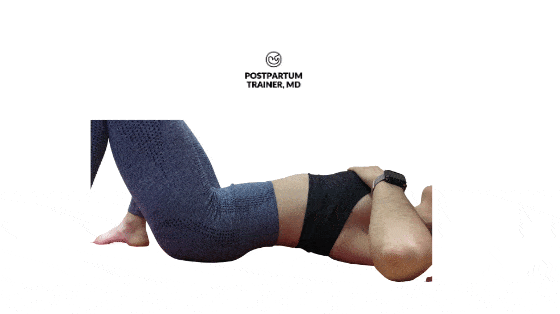
- Start by lying on your back with your knees bent and feet flat on the floor.
- In this position, a natural curve (arch) in your lower back should create a small gap between you and the floor.
- From here, posteriorly rotate your pelvis while pressing your belly button towards the floor.
- Your lower back should completely flatten against the floor.
- Hold this contraction for 3 seconds and release.
- Repeat for ten repetitions.
The great thing about this exercise is that you can’t do it wrong. You physically cannot achieve this position without activating your core!
Plus it can also help reduce lower back pain!
I created a 7-day exercise program to kick start the restoration of your core muscles.
This mommy pooch workout will show you a few other abdominal exercises you can do to help you get started today.
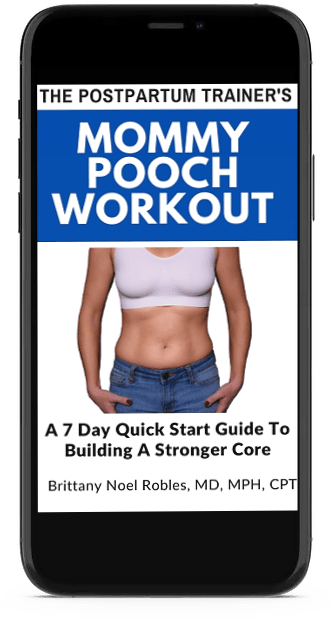
Tip #3: Be Patient and Stay Consistent
Losing the mommy belly won’t happen overnight.
But every healthy meal and every workout session builds upon itself.
Celebrate non-scale victories like having more energy to play with your baby.
Let the small fitness and nutrition habits you build now spur a lifelong healthy lifestyle transformation.
You’ve achieved fantastic strength carrying and birthing this baby. Maintain that inner power to better yourself a little at the time.
When Should You Consider Surgery?
If you do not see improvements in your abdomen after 6 months of consistent diet and exercise, you can consider surgical options as a last resort.
A tummy tuck surgery (abdominoplasty) is the most common procedure to target this area.
With that said, any surgerical procedure come with risks. Be sure to speak with your providers to see if surgical repair is a good option for you.
What Is The Difference Between Diastasis Recti And Mommy Belly?
Diastasis recti is the condition that develops when your abdominal muscles separate along the midline.
So, diastasis recti exists in ALL women who have a mommy pooch.
But with that said-
Not every woman with diastasis recti will have a bulge. It all depends on your anatomy and the degree of abdominal separation.
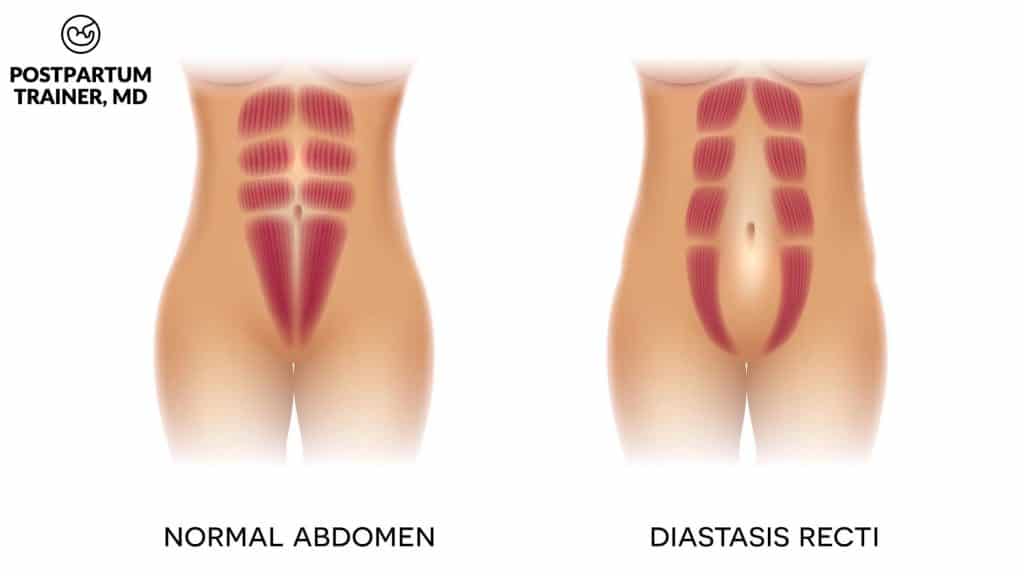
Can You get a mommy pooch after A c-section?
Yes, you can get a mommy pooch after a c-section.
The stretching and weakening of your abdominal wall are independent of the type of delivery you had.
Regardless, your abdominal muscles and connective tissue must stretch to support your growing baby and uterus.
As your uterus gets bigger, your abdominal muscles and fascia will weaken.
So, having a c-section does not prevent the diastasis or mommy pooch from developing.
How long does it take to get rid of The Pooch?
Based on the hundreds of postpartum women I have worked with, consistency is vital when eliminating the pooch.
When you are consistent with diet and exercise, you may see improvements in as little as six weeks.
This process could take longer depending on how wide the separation of the abdominal muscles is.
In some cases, diet and exercise may never completely eliminate the pooch altogether.
As with anything, the best thing you can do is stay consistent.
Final Words
Getting rid of a postpartum mommy pooch takes time, consistency, and commitment.
But the effort is worth it.
The key strategies to lose the postpartum belly fat are:
- Follow a whole food diet lower in carbs and higher in protein to reduce overall body fat
- Perform transverse abdominis exercises to strengthen the deep core muscles 2-3x per week
- Remain consistent with your diet and workout plan for at least six weeks
- Be patient – it takes time for lifestyle changes to take effect
Feel proud of yourself, and remember – your body did an incredible thing carrying a baby!
Related Posts on The Mommy Pooch
- Mommy Tummy Overhang and How to Get Rid of It
- FUPA: What Is It and How to Lose It
- 5 Effective Exercises To Strengthen The Pelvic Floor Muscles Postpartum
- Loose Skin After Pregnancy and What You Need to Know
Get Four Free Workouts To Help Strengthen Your Pelvic Floor & Heal Your Mommy Tummy!

Brittany Robles, MD, MPH, CPT
Brittany Robles is a full-time OBGYN physician, a NASM certified trainer, and a prenatal and postnatal fitness specialist. She holds a Master of Public Health degree in maternal health with a special interest in exercise and nutrition. She is also the co-author of The White Coat Trainer. Learn more about her here.
Sharing is Caring – Send This To A Mom In Need!

I have had 3 vertical cesareans in my late twenties now 65 I am at my ideal weight but cannot lose the pooch? Will I ever have an muscles?
Hi Patti,
Thank you so much for your comment.
Losing the mommy pooch can be quite difficult as it largely depends on genetics.
Although you are at your ideal body weight, you could still have a high body fat percentage. Do your best to continue improving your nutrition as much as possible as well as engaging in a core focused exercise regimen. There is a chance it may never go away.
Hope this helps!
Hi ! This makes so much sense. I really want to know more & excited to start I’m a mommy of 3 & I’ve had 2 natural births one cesarean. I’m 26 weighing 145 im 5’6, I’m not big but I have a mommy pouch & feel bloated all the time & I feel out of shape.
Hi Yalitza,
Thank you so much for your comment.
Be sure to download the free PDF to get started!
Good luck 🙂
Hi Dr Brittany! Your article and explanations were very helpfull! I have two C-section deliveries and my second one was at 40 years old. First experience was at 36 and I had lost wait more than I had when started the pregnacy. But now, at 42 years old I’m fighting to lose 10 more kgs to reach my normal weight and I don’t know what else to do. I tried eating healthy, got rid of fatty meals, extra sugar, reduces sweets, no snacks, lots of water, no soda drinks qnd so on but it doesn’t seem to work. Unfortunatelly I didn’t find time to exercise but I walk daily when taking out the kids to the park, I am active and energetic. Your article made me look at a different perspective knowing now more details about diastatis recti and those special exercoses! Tjank you for sharing! I will try more, this time!
Hi Monica,
Thank you so much for your comment!
It seems you are doing all the right things when it comes to healthy eating. Definitely try to add in some form of exercise to compliment your current lifestyle!
I had a emergency c section been 2yrs first baby can I loose the over hang belly ?????
Hi Jusna,
Thanks so much for the comment and yes you can lose the overhang even if you have had a c-section!
It’s been 3 years since my last c-section and I know that genetics are not on my side. I have been able to add more excercise lately, and I am running a couple of miles per week (3 times). However, I overeat and consume too much processed food (sweets), it is my weakness. I know what to do but I clearly don’t follow through. I feel like my best option is to look into the belly tuck, which is also time consuming and costly but I feel it will take 5-10 years before I see results and that does not motivate me.
I’ve had my only daughter at 27 a natural birth, I was size 10-12 before pregnancy now I’m a 16 on bottom and a 18-20 on top and I don’t particularly big boobs, it’s all my belly, it’s constantly bloated there’s no saggy skin I literally look exactly how I did after giving birth, I was referred by my GP for a scan and it came back clear but the lady doing the scan said I’m very gassy and she could see the gas, I’m not sure how to proceed. I admit I have a good diet not any processed food for main meal they are all homemade but I do eat alot of Brean and cakes biscuits things like that and I drink alot of tea. I’ve downloaded your pdf so will try the exercises on top of my daily walks with my daughter but is there any other advice you can give me on where to start cause I’m feeling very disheartened especially with not only putting on some extra weight, which I could of dealt with that but this swollen stomach is awful, It gets so hard sometimes it’s quite uncomfortable. Any help much appreciated 🙂 thankyou
Hi Natalie,
Thank you so much for your comment and congratulations on your daughter!
I am glad to hear your scan came back clear.
Regarding your abdominal weight gain I would stay away from processed foods as well as cakes and biscuits as these are usually full of empty calories and don’t really provide much nutrition.
Try using an app to track your calories and macros to see if you are consuming an adequate amount and make changes as needed.
In addition, make sure you are drinking enough water as teas can sometimes make you dehydrated especially if they are caffeinated.
Lastly, try engaging in exercise which can aid weight loss, decrease body fat, and strengthening your abdominal muscles.
Hope this helps!
It’s been 3 years since my natural birth, and I’ve always been curious as to when I can go back to doing normal Abdominal exercises. Even trying to do regular crunches I get a horrible charli horse on my abdominal muscle.
Hi Nicole,
Thank you so much for the comment.
Make sure to always stay hydrated before and after exercise and ensure you are cleared to work out by your doctor.
If you google “100 Diastasis Recti Exercises” you will find one of my posts that have a ton of abdominal training exercise alternatives to traditional crunches.
If any exercise causes you pain you should avoid it!
Hope this helps!